
The Queen's Own Royal West Kent Regiment was a line infantry regiment of the British Army based in the county of Kent in existence from 1881 to 1961. The regiment was created on 1 July 1881 as part of the Childers Reforms, originally as the Queen's Own (Royal West Kent Regiment), by the amalgamation of the 50th (Queen's Own) Regiment of Foot and the 97th (The Earl of Ulster's) Regiment of Foot. In January 1921, the regiment was renamed the Royal West Kent Regiment (Queen's Own) and, in April of the same year, was again renamed, this time as the Queen's Own Royal West Kent Regiment.

The Home Counties Division was an infantry division of the Territorial Force, part of the British Army, that was raised in 1908. As the name suggests, the division recruited in the Home Counties, particularly Kent, Middlesex, Surrey and Sussex.
The 131st Infantry Brigade, originally the Surrey Brigade was an infantry formation of Britain's Territorial Army that saw service during both the First and the Second World Wars. In the First World War the brigade was in British India for most of the war and did not see service as a complete unit but many of its battalions would see service in the Middle East.

The 132nd Infantry Brigade was an infantry brigade of the British Army that remained in British India during the First World War. During the Second World War, it served with the 44th Infantry Division in Belgium and France, later being evacuated at Dunkirk and seeing service again in North Africa at El Alamein before being disbanded in January 1943.
The 25th Infantry Brigade was a war-formed infantry brigade of the British Army that saw active service during both the First and the Second World Wars.

The Middlesex Regiment (Duke of Cambridge's Own) was a line infantry regiment of the British Army in existence from 1881 until 1966. The regiment was formed, as the Duke of Cambridge's Own (Middlesex Regiment), in 1881 as part of the Childers Reforms when the 57th (West Middlesex) and 77th (East Middlesex) Regiments of Foot were amalgamated with the county's militia and rifle volunteer units.

The Royal Sussex Regiment was a line infantry regiment of the British Army that was in existence from 1881 to 1966. The regiment was formed in 1881 as part of the Childers Reforms by the amalgamation of the 35th Regiment of Foot and the 107th Regiment of Foot. The regiment saw service in the Second Boer War, and both World War I and World War II.

This is the order of battle for the Battle of Alam el Halfa, a World War II battle between the British Commonwealth and the Axis Powers of Germany and Italy in North Africa between 30 August and 5 September 1942. The forces were the Eighth Army and the Panzer Armee Afrika

The East Midland Brigade was an infantry brigade of the Territorial Force, part of the British Army, that was raised in 1908. As the name suggests, it commanded infantry battalions recruited in the East Midlands of England: Bedfordshire, Northamptonshire, Cambridgeshire and Hertfordshire. The brigade was an integral part of the East Anglian Division.

The 37th Brigade was an infantry brigade of the British Army that served in both the First and the Second World Wars.
The 2nd Kent Brigade was a 2nd Line Territorial Force Brigade of the British Army in World War I. The brigade was formed as a duplicate of the Kent Brigade in October 1914 as part of the 2nd Home Counties Division. As the name suggests, the brigade recruited in Kent. In August 1915, in common with all Territorial Force brigades, it was numbered as 202nd Brigade. Between September 1917 and the end of the year, the brigade was extensively reorganized and lost its territorial identity; henceforth it was known as 202nd Brigade.

The 219th Brigade was a Home Service formation of the British Army during the First and the Second World Wars.
The 134th Infantry Brigade was an infantry brigade of the Territorial Force, part of the British Army. It was formed in the First World War as a duplicate of the Hampshire Brigade and was originally formed as the 2nd/1st Hampshire Brigade in 1914–1915 before later being renamed as the 134th Brigade. It was sent overseas to India in December 1914 to relieve Regular Army units for service in France. The brigade remained there for the rest of the war, supplying drafts of replacements to the British units fighting in the Middle East and later complete battalions. By September 1917 the last of its battalions had departed.
The 136th Infantry Brigade was an infantry brigade of the Territorial Force, part of the British Army. It was formed in the First World War as a duplicate of the Devon and Cornwall Brigade and was originally formed as the 2nd/1st Devon and Cornwall Brigade in 1914–1915 before later being renamed as the 136th Brigade. It was sent overseas to India in December 1914 to relieve Regular Army units for service in France. The brigade remained there for the rest of the war, supplying drafts of replacements to the British units fighting in the Middle East and later complete battalions.
The 225th Brigade was a Home Defence formation of the British Army in the First and the Second World Wars. It existed under several variations of the 225th Brigade title.
The 2nd Home Counties Division was a 2nd Line Territorial Force division of the British Army in World War I. The division was formed as a duplicate of the 44th Division in November 1914. As the name suggests, the division recruited in the Home Counties, particularly Kent, Middlesex, Surrey and Sussex. In August 1915, in common with all Territorial Force divisions, it was numbered as 67th Division. Between September 1917 and the end of the year, the division was extensively reorganized and lost its territorial identity; henceforth it was known as 67th Division.
The Kent Cyclist Battalion was a bicycle infantry battalion of the Territorial Force, part of the British Army. Formed in 1908, it was sent to India in the First World War and saw active service during the Third Anglo-Afghan War in 1919. In 1920, it was converted as part of the Royal Artillery.
The Hampshire Brigade, previously the Portsmouth Brigade and later 128th (Hampshire) Brigade, was an infantry formation of the British Army of the Volunteer Force, Territorial Force (TF) and Territorial Army (TA) in existence from 1889 until after the Second World War. It served in British India during the First World War, but not as a complete formation. During the Second World War, the 128th Infantry Brigade fought in the Tunisia Campaign, in the Italian Campaign, and later in the Greek Civil War. The brigade was composed entirely of battalions from the Hampshire Regiment.
The 2nd Sussex Rifle Volunteers was a part-time unit of the British Army first raised from the county of Sussex in 1859. It later became the 4th Battalion, Royal Sussex Regiment. A detachment served in the Second Boer War. During the First World War, the battalion fought at Gallipoli, in Sinai and Palestine, and then in the final months of the war on the Western Front. In the Second World War, both the battalion and its duplicate served in the Battle of France and were evacuated from Dunkirk. The 4th Battalion then fought at the Second Battle of El Alamein, and served in the Middle East until the end of the war. It continued in the postwar Territorial Army until it lost its individual identity in a series of mergers from 1967.
The 1st Cinque Ports Rifle Volunteers was a part-time unit of the British Army first raised from the Cinque Ports of Kent and Sussex in 1859. It later became the 5th Battalion of the Royal Sussex Regiment. During the First World War, it served on the Western front as pioneers, seeing a great deal of action at Aubers Ridge, the Somme, Ypres, and in Italy. In the Second World War, both the battalion and its duplicate served in the Battle of France and were evacuated from Dunkirk. The 5th Battalion then fought at the Second Battle of El Alamein while its duplicate unit served as an anti-aircraft regiment in the campaign in North West Europe. Neither unit was reformed after the war.









